Thutmose III
Thutmose III. (* c. 1486 BC; † 4 March 1425 BC) was the sixth ancient Egyptian king (pharaoh) of the 18th Dynasty (New Kingdom). He ascended the throne on 4 Shemu I 1479 BC and reigned until 30 Peret III 1425 BC.
Thutmosis III came from the marriage of king Thutmosis II with a concubine named Isis. Main wife of Thutmosis II was Hatshepsut. Since Thutmosis III was obviously still a child when he ascended the throne, his stepmother Hatshepsut, who was at the same time his aunt, led the affairs of government. Presumably, Hatshepsut took over the throne between the 2nd and 7th year of their joint reign by making herself sole ruler. Time and extent of the repression of Thutmosis III are disputed in the research. Differently dated texts indicate that the reign of Hatshepsut ended at the latest in the 22nd year of her reign and that Thutmosis III then took over the sole reign.
The 22nd regnal year of Thutmosis III also initiated the prelude for almost yearly campaigns to the Near East. The first campaign was the so-called battle of Megiddo against a coalition of Syrian princes under the leadership of the prince of Kadesch. The aim of the Egyptians was on the one hand the destruction of the Near Eastern power bases out of fear of further foreign domination over Egypt (following the rule of the Hyksos) and on the other hand there was an economic interest in the region. Egypt profited from rich trade goods and tributes such as labour, natural resources and raw materials, which ensured an unprecedented prosperity for the country. Further major field battles occurred in the 8th, 10th and 16th campaigns. The enemy was now the empire of the Mitanni. This could be weakened enormously in each case.
In addition to the Near East, Egypt also expanded into Nubia, south of the 1st Nile cataract at Aswan, in the early 18th Dynasty. Thutmosis III was able to move Egypt's southern border permanently beyond the 4th cataract and fix the southern end at Gebel Barkal ("Pure Mountain") with Napata as a border town and trading post.
The kings of the 18th dynasty felt especially connected with the imperial god Amun in Karnak. Accordingly, the temple district of Amun was significantly expanded and restored under Thutmosis III. A central building in Karnak is the Ach-menu, also simply called "festival temple", which he had built in the 24th year of his reign.
Thutmosis III built his first mortuary temple in Thebes-West near the present place Qurna and in the last ten years of his reign another one in Deir el-Bahari. The king was buried in tomb KV34 - 'KV' stands for 'Kings' Valley' - which is located in a narrow rocky gorge in the southernmost wadi in the Valley of the Kings. The mummy of Thutmosis III was later transferred to the "Cachette of Deir el-Bahari" where it was discovered in the 1870s.
Possibly Thutmosis III appointed his son and successor Amenophis II already in his last years of reign as co-regent.
Origin and family
Only a few generations before Thutmosis III the so-called Hyksos (Heka-chasut - "rulers of the foreigners"), who were probably immigrants from the Near East, ruled over a large area of Lower Egypt. Finally, at the end of the 17th Dynasty, a long-established Theban princely dynasty, also known as the "Ahmosids", succeeded in driving the Hyksos out of Egypt: After the kings Seqenenre and Kamose had already undertaken several campaigns against the Hyksos, it was Ahmose who captured their capital Auaris and forced the Hyksos to leave. In doing so, he established the New Kingdom. It is assumed that important driving forces of the unification of the empire were also Ahmose's grandmother Tetischeri and after her death Ahmose's mother Ahhotep I..
Amenophis I, the son of Ahmose and his Great Royal Wife Ahmose Nefertari, took over the government after Ahmose's death. Amenophis and his mother were deified in later times and venerated, especially in the Ramesside period, as patrons of the necropolis workers at Set-maat, now Deir el-Medina. Amenophis I apparently left no male heir to the throne. After him Thutmosis I came to power, whose origin is unclear. He attained the right to the throne by a marriage with the princess Ahmose, a daughter of Amenophis I. With Thutmosis I began the so-called Thutmosid dynasty and thus the actual line of descent of the 18th dynasty. The historian Manetho let begin the 18th dynasty with the kingdom unifier Ahmose, however, genealogically Ahmose and Amenophis I still belong to the 17th dynasty.
From the marriage of Thutmosis I and Ahmose came Hatshepsut, the heir to the throne Thutmosis II, however, from the marriage with the concubine Mutnofret. The half-sister Hatshepsut became the main wife of Thutmosis II, presumably to maintain the "pure blood" and to legitimize the claim to the throne. Among others, the eldest daughter of the king, Neferure, resulted from this marriage. However, Thutmosis III came from the marriage with the concubine Isis, about whose origin almost nothing is known. Isis probably came from a noble family which enjoyed good relations to the royal house and Angelika Tulhoff assumes that she was admitted to the royal women's palace as a sign of favor of the king.
The main wife of Thutmosis III with the title Great Royal Wife was Satiah, the daughter of the royal nurse Ipu. From this marriage perhaps the first heir to the throne named Amenemhat was born. In the 24th year of his reign this Amenemhat is called the eldest son of the king and according to an inscription in the festival temple at Karnak he was appointed "overseer of the cattle for the herd of Amun". At this time Satiah was still chief consort. Other children from this marriage included a daughter named Nefertari and another son named Sa-Amun. Prince Amenemhat died between the regnal years 24 and 35. Satiah probably also died early, because after the 33rd regnal year she is not mentioned any more, also probably Sa-Amun. Thutmosis III finally married the "civil" Meritre Hatshepsut and appointed her as the Great Royal Wife. She gave birth to the successor Amenophis II as well as the two daughters Merit-Amun and Tija. The inscription on a scarab mentions another daughter named Baket by a concubine.
A depiction on a pillar in the central chamber of his tomb (KV34) also gives information about the female family members of the king: Beside the still living king's mother Isis the still living second main wife Meritre Hatshepsut appears behind it. Behind this Satiah appears who is identified as "justified", i.e. deceased. Behind this follows another, more insignificant king's wife named Nebtu. This one must have been a wealthy and influential woman, for she had her own property manager. Also on this pillar the daughter Nefertari is depicted, but she had also died at this time, as can be inferred from the inscription ("justified").
Three further concubines named Manhat, Mahnta, and Manawa are known from their common tomb in the small Wadi Quabbabat el-Qurud in Thebes-West. Due to their phonetically written, foreign names, these could be identified as Syrian women. The tomb is especially known because of the discovery of numerous pieces of jewellery, cosmetic vessels and precious tableware. An exact dating of the burial is not possible, although there are some indications that they were buried already in the youth years of Thutmosis III. Angelika Tulhoff assumes that the three Syrian women already came to the court under Thutmosis II and were taken over by the successor of Thutmosis III according to the moral customs.
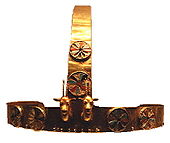
Diadem or crown from the tomb of the three Syrian wives
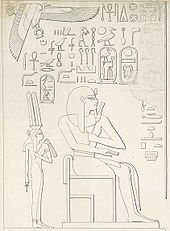
Meritre Hatshepsut (left) next to Thutmosis III.
_-_TIMEA.jpg)
Thutmosis II, father of Thutmosis III.

Depiction of Thutmosis III and his family in his tomb KV34: Top: Thutmosis III and his mother Isis in the barque. Below: Thutmosis III being suckled by his mother Isis (depicted as a tree). Beside: Thutmosis III, Meritre Hatshepsut, Satiah, Nebtu, and Nefertari.
Construction Activity
Construction projects in Karnak
The kings of the 18th dynasty felt especially connected with the imperial god Amun in Karnak. Accordingly, the temple district of Amun was significantly expanded and restored under Thutmosis III.
New construction of the central barque sanctuary
The barque sanctuary around the 5th pylon which had been built only a few years before by Hatshepsut was replaced by a new building of black granite, divided by another small gate building and extended by a small porch. In the small courtyard in front of this extension must have stood the two small "golden shining" obelisks of Thutmosis III which were captured during the conquest of Thebes by the Assyrians in the 7th century BC. On the western outer wall of the southern part of the central building Thutmosis erected a false door whose former equipment with gold and precious lapis lazuli is reported by a dedication inscription. Of special inscriptional interest is the so-called Annals Hall which extends along the walls of the courtyard in front of the barque sanctuary and along the northern enclosure wall. The texts engraved here in the 40th year of the reign give a vivid account of the king's military actions.
Reconstruction and extension of the Central Sanctuary and the Hall of Columns
The holy district between today's 4th pylon and the festival temple of Thutmosis III. (Ach-menu) was called Ipet-Sut (jpt-swt - "place of election") by the Egyptians. The oldest building section from the Middle Kingdom was left in its original state because of its sacred nature and the later buildings were built around this area. Thutmosis III had the portico (colonnade) which had been built by Thutmosis I around the central sanctuary of the Middle Kingdom removed and replaced by many small chapels which were built close to each other. In these chapels statues of deceased rulers were venerated.
The two-part columned hall, the so-called Wadjit, was erected under Thutmosis I and remodeled under Hatshepsut. Among other things, two obelisks of rose granite originated from her, one of which is still preserved in situ. Thutmosis III had all columns of the hall replaced by a double row of massive papyrus columns of sandstone. The Osiris pillars of Thutmosis I were surrounded by a "tongue wall" to give the impression of statue niches. The obelisks of Hatshepsut were walled in such a way that they were no longer visible inside the building but still visibly towered over the temple building from the outside. Two further obelisks were erected by Thutmosis III on the occasion of a Sed festival directly in front of the obelisks of Thutmosis I at the entrance of the central sanctuary (4. pylon). These were removed for the construction of the 3rd pylon by Amenophis III.
Construction of the Ach-menu (festival temple)
In the 24th year of his reign Thutmosis III erected the Ach-menu, also simply called "festival temple", east of the area of the Middle Kingdom. Its detailed name is Men-cheper-Ra-ach-menu which means as much as "Glorious in monuments is Men-cheper-Ra (Thutmosis III)" or also "Sublime is the memory of Men-cheper-Ra".
The center of the building is a large festival hall, next to it there are rooms for the cult of Amun and Sokar, a double sanctuary where secret mysteries were held, and a higher room for the cult of the sun, accessible via a staircase. The sanctuary is oriented north-south, but it also takes into account the east-west axis of the main temple. Contrary to the usual arrangement for an Egyptian temple of the New Kingdom, the main entrance is at the end of a long corridor and the actual sanctuary is only reached after a 90° turn via an anteroom.
The approximately 40-metre-long festival hall is the oldest known example of a basilical building: The roof of the central nave is supported by a double row of 10 columns each and the surrounding side aisles by a total of 32 pillars. The shape of the columns imitates in a monumental way the wooden frame of a tent. Thus, it is a marquee converted into stone, which played a central role in the ritual acts of the Sed festival.
On the walls of a small chapel in the southwest corner of the hall was the so-called King's List of Karnak. On it the pharaoh stands sacrificing before a total of 61 seated kings. This royal genealogical table is of importance for the historical-relative chronology.
The Ach-menu is also called the million-year house. It is similar in design to the million-year houses of the Theban west bank, with a solar cult site on the roof, a Sokar sanctuary, and a chapel for the cult of the ancestral kings. Viewed in this light, "it is conjectured that the building was dedicated primarily to the cult of the king as a manifestation of Amun-Re." Piotr Laskowski goes even further in his interpretation: The stela CG 34012 tells about miracles which happened during the foundation ceremony. Unexpectedly Amun took part in the ceremony and performed the founding rites. This can be understood as a sign of a perfect union between the god and the king. Thutmosis III founded the temple for Amun and was at the same time a form of Amun. Thus, he founded a temple which served the purpose of his own cult.
The "botanical garden
Exceptional is the "botanical garden" in the northeastern part of the Ach-menu. During the third campaign in the 25th year of his reign to the region of Retjenu Thutmosis III collected according to the inscription "all rare plants and beautiful flowers" and also animals to donate them to the temple of Amun at Karnak. Equally extraordinary is that this variety of non-Egyptian plants and animals was depicted with botanical and zoological meticulousness on the reliefs. In contrast to the usual conventions in Egyptian art, the animals, plants and plant parts are often represented not on a standing line, but freely distributed on the surface. They are depicted on their own, more in the sense of a descriptive catalogue than an ecological or functional integration into a scene.
In total, Nathalie Beaux was able to identify 86% of the plant species depicted and 30 of the 36 bird depictions. It remains questionable, however, whether all plants and animals were collected during a campaign or whether they did not also reach Egyptian hands through trade or as gifts. It is also impossible to say whether they were only documented on site or whether they were actually brought to Egypt and perhaps even acclimatized. Thus, already the representations in the Punt Hall of Hatshepsut at Deir el-Bahari show that exotic plants and animals were imported as trade goods. The account of the exploration of Punt shows a world whose novelties are noticeably overcome.
This interest in the exotic, however, did not arise from a purely scientific curiosity. In transferring these landscape observations into the monumental context of a temple, Kai Widmaier thinks of forms of appropriation and appropriation of the exotic foreign into own-cultural contexts. Nathalie Beaux understands this as a form of symbolic border expansion, in which either the actual foreignness achieved or extraordinary elements of the unknown were adopted into the decoration program of the temples.
Construction of the East Temple
The so-called eastern temple lies behind the Ach-menu at the eastern wall of the temple wall. Probably, Thutmosis III had an older sanctuary of Hatshepsut removed or changed here. The small complex consists mainly of a shrine to Amun. Originally, two obelisks from the time of Hatshepsut flanked the sanctuary. Thutmosis III commissioned another obelisk which, however, was not completed until the reign of Thutmosis IV. It was brought already in the antiquity to Rome where it stands since then on the Piazza San Giovanni in Laterano and is called Obelisco Lateranense.
Extension of the north-south axis
A second temple axis of the temple of Amun starts in front of the 4th pylon and is aligned southward to the Mut-district and the temple of Luxor which is three kilometers further away. Already Hatshepsut had this boulevard enlarged by festival courts, station chapels and the 8th pylon, however, only Thutmosis III was able to complete the pylon. Already existing inscriptions were adapted accordingly to his reign.
He had another gate area, the 7th pylon, erected between the 8th and the 4th pylon. A well preserved relief scene shows Thutmosis III as commander slaying the enemies. In front of the entrance area of the pylon once stood two colossal statues, of which the one on the right represented Thutmosis III and the one on the left the later king Ramses III, but they are destroyed except for the base and remains of the foot and leg area. Immediately in front of them two obelisks of Thutmosis had been erected. The upper part of the western one was already brought to Constantinople in antiquity and is today on the Istanbul Hippodrome Square. The remains of the lower part of the eastern obelisk are still on site.
Between the 7th and 8th pylon the architects of Thutmosis III built a station chapel in the 30th resp. 34th year of his reign which served as a resting place for the cult image of Amun during solemn processions. The poorly preserved complex was oriented towards the Holy Lake.
An important part of the temple area was the rectangular sacred lake, 200 × 177 meters. In this lake the priests performed purification ceremonies before entering the temple. Probably, the water basin was rebuilt and redesigned under Thutmosis. This symbolizes the primeval ocean Nun, which at the beginning of time covered the entire surface of the earth and from which the sun god emerged at the creation.
New construction of the Ptah temple
Beside the imperial god Amun also Ptah, the main god of the old imperial city Memphis, had a place of worship in Karnak. At least since the beginning of the 18th Dynasty there was a small sanctuary made of mud bricks and with wooden columns. Already after the first campaign in the 23rd year of his reign Thutmosis ordered the rebuilding of this building. The new sanctuary of stone consisted of three connected rooms and a small hall in front of it, the roof of which was supported by two columns. It was extended under king Shabaka and in Ptolemaic times.
Construction projects in Thebes-West
The temple of the dead in Qurna
→ Main article: Mortuary temple of Thutmose III. (Qurna)
The first mortuary temple was built by Thutmosis III 400 meters southwest of the beginning of the way to the mortuary temple of Mentuhotep II and 300 meters northeast of the Ramesseum in Thebes-West at today's place el-Qurna. Thus, with the choice of the building site he continued the sequence of the funerary temples to the southwest which had been started by Amenophis I and which subsequently continued to Medinet Habu.
Exactly when Thutmosis began with the construction of the mortuary temple is not known. The earliest recorded mention is in the Red Chapel, on a black pedestal block (No. 290). This proves that the building was erected already in the time of the co-regency with Hatshepsut, because the Red Chapel, a barque room of Hatshepsut, was erected in the 16th year of the joint reign. In it the mortuary temple of Thutmosis is mentioned among the temples providing sacrifices. Accordingly, it was already finished and in use in a first version in the 16th year of the reign.
The lack of epithets in the name ring of most of the brick temples in the enclosing wall of the first construction phase and the modest size of the temple also speak for the start of construction in the first years of the reign.
Another dated mention dates from the 23rd year of his reign. In the annals of the Annals Hall in the temple of Karnak Thutmosis III mentions that the victory feast of the third Asian campaign was celebrated in the temple of the dead.
The epithets of the king on the brick temples indicate that also in the time of the sole government the construction of the temple was continued. The sanctuary of Hathor was apparently completed under the successor of Amenophis II. Especially during the sole reign the temple seems to have been extended and rebuilt. According to Ricke because Thutmosis III did not want to let the temple appear too modest next to his giant complex at Deir el-Bahari and because he could expand the cult from the funds of the Asian campaigns and needed more space for this development.
The temple of the dead in Deir el-Bahari
→ Main article: Mortuary temple of Thutmose III. (Deir el-Bahari)
In the last ten years of his reign Thutmosis built another mortuary temple, the Djeser-achet ("Holy (from the) Horizon"), at Deir el-Bahari. The start of construction may have coincided with the damnatio memoriae of queen Hatshepsut and the related destruction of her temple. Construction supervisor was the Tjati Rechmire.
It was not until 1961/62 that a team of Polish archaeologists led by Kazimierz Michałowski and later by Jadwiga Lipińska discovered the temple and uncovered it in five years of excavation work.
Since Thutmosis already had a mortuary temple and also the Ach-menu at Karnak is described as such, the determination of the function of the temple is more difficult. According to Dieter Arnold it was not a royal mortuary temple, "but rather a replacement for the chapels of the gods of the temple of Hatshepsut which had been damaged shortly before by the persecution of Hatshepsut, thus, above all for its Amun sanctuary and the sanctuary of Hathor". Accordingly, the temple took over the function of the mortuary temple of Hatshepsut as the last station at the valley festival during which the cult image of Amun was carried in a procession of the gods to Deir el-Bahari, whereby the temple of Hatshepsut lost its importance. According to Sergio Donadoni, however, the reigning king, which had been Thutmosis III for a long time, was due the honor to host the god overnight in his mortuary temple. According to Donadoni's interpretation only the last stage of the valley festival was transferred from the first mortuary temple Hut-henket-anch in el-Qurna to Djeser-achet in Deir el-Bahari.
The Tomb in the Valley of the Kings
→ Main article: KV34
The tomb of Thutmosis is located in a narrow rock gorge in the southernmost wadi in the Valley of the Kings in Thebes-West. It bears the number KV34. Workers of Victor Loret, the then Director General of the Egyptian Department of Antiquities, discovered it on February 12, 1898.
Like all early tombs in the Valley of the Kings, the bent shape of the floor plan and the oval coffin chamber reflect the curved spaces of the subterranean afterlife.
An entrance in the north leads to the first corridor and further in a "rhythmic alternation of stairs and corridors" to a first chamber with a central ramp, a second corridor and via a shaft to the trapezoidal upper pillared hall, which makes a bend in the axis at an angle of 72.64 degrees and leads down via a staircase to the burial chamber, which in turn has four side rooms. As in all tombs of the 18th Dynasty, corridors and staircases remained without decoration.
The walls of the trapezoidal antechamber show a catalogue of 741 deities (without the hostile beings) from the Amduat, which is without comparison. The figures are drawn only in outline and each is completed with a star and an incense burner as well as a sign for the Ba-soul.
The 14.6 m × 8.5 m burial chamber is rectangular with rounded corners and resembles a cartouche. The walls are decorated with the twelve night hours of the Amduat, the arrangement of which is based on the real cardinal points and the notes in the text: Hours 1-4 are on the west wall, 5 and 6 on the south wall, 7 and 8 on the north wall, and 9-12 on the east wall. However, this ideal could not always be adhered to and certain rearrangements and omissions had to be made due to lack of space. The figures are painted in black and red line drawings, the texts in cursive hieroglyphics, and the background is in a light yellow-red tone. This gives the impression of a monumental papyrus.
Two pages of the two pillars contain an abridged version of the Amduat book ("The Scripture of the Hidden Chamber") as a kind of table of contents. On four pages, 76 figures of the Litany of the Sun are depicted.
Another scene on a pillar is the depiction of the king with his mother Isis in a boat and accompanied by family members. In addition, an unusual and well-known scene is fleetingly sketched: a stylized tree reaches out to the king's breast. It bears the inscription: "he sucks at (the breast of) his mother Isis". Since Thutmosis' mother was indeed named Isis, the scene could superficially be interpreted as the king's return to his mother and rejuvenation, but the tree points to a goddess who otherwise grows out of the tree in the tombs of officials as Nut or Hathor, offering cool water and sacrificial food to the dead with his bird-shaped ba. That Isis is called here instead is certainly due to the name of the earthly mother, but also to the myth according to which the king represents the role of Horus on earth and returns to the protection of his divine mother Isis who cares for and protects him.
The royal sarcophagus forms the shape of a cartouche and can still be seen in the tomb. The mummy was discovered in 1881 in the cachette of Deir el-Bahari (TT320), wrapped in a shroud with the text of the Litany of the Sun.
The small temple in Medinet Habu
In Medinet Habu, the southernmost area of the Theban necropolis, lies a religiously important sanctuary of the primeval Amun. It was regarded as the tomb of the Ur-Amun Kematef, at which Amun of Karnak regenerated every ten days. Over a small building of the 11th dynasty a sanctuary called Djeser-Set (ḏsr-st) was erected in the time of the coregency with Hatshepsut. This sanctuary consisted of the sanctuary proper with six rooms and a barque chapel with a pillared ambulatory placed in front of it.
Two rooms were decorated only during the reign of Thutmosis: Room L, an antechamber leading to two cult rooms and containing a double statue of black granite showing Thutmosis III and Amun, and Room M, which is called the sanctuary of the king by Uvo Hölscher. The latter had no connection to the other rooms of the temple. The decoration shows Thutmosis III sitting in front of the offering table and worshipped by Inmutef priests.
The most important project of Thutmosis was the enlargement of the barque shrine to which the columned hall planned by Hatshepsut fell victim. The new shrine was exactly the same width as its predecessor, but twice as long.
During the construction of the mortuary temple of Ramses III the small temple from the 18th dynasty was included in its enclosure.
Memorial temple of Thutmosis II.
Near Medinet Habu, north of the small temple, Thutmosis III erected another temple. This one was dedicated to the cult of the dead for Thutmosis II. Whether it was a million year house is uncertain, since no inscription with such a designation was found. However, as Luc Gabolde pointed out, the million year house of Tutankhamun is almost an exact copy of this temple, so that one could assume that this could indeed be a million year house of Thutmosis II.
The temple was built with two different types of limestone in two phases. A limestone block of Hatshepsut could indicate that the temple was built in a first phase during the reign of Hatshepsut. Possibly, it was abandoned shortly thereafter. When Thutmosis III decided to rebuild the temple in memory of his father is difficult to say. Certainly, Thutmosis II became an important element of the king's ideology in the course of the dishonor of Hatshepsut.
Construction activity in Heliopolis
The sun cult site at Heliopolis (Iunu) was the center of the Egyptian re-cult and the cult of the pillars, especially the obelisks. However, because of modern field use and overbuilding, it is one of the least explored major sites in Egypt. Thutmosis III ordered the construction of a new pylon in Heliopolis, in front of which two obelisks about 21 meters high were erected on the third Sed festival. These were brought to Alexandria in 13/12 B.C. and erected in the Caesareum, where they were regarded as the "Needles of Cleopatra". One toppled over in 1301 and was taken to London in 1877, the other remained upright and was transported to New York in 1880. In the 47th year of her reign, the Temple of the Sun received a new enclosing wall.
Further construction activity outside the Theban area
Thutmose's building activity outside Thebes is an important source of his royal building program and the history of his reign. Thebes was not the capital of the country in the modern sense. Heliopolis was equal to Thebes in religious importance. The royal residence was probably not fixed to one place, and the king traveled throughout the country. Certainly he resided at Armant, as the inscription of Iamu-nedjeh testifies. It is attested that a Harim palace existed at Gurob. The king's son was brought up at Memphis. Some sort of warlike resistance was probably made from Peru-nefer.
The most important building activities of Thutmosis III. (from south to north) are:
- Gebel Barkal: Victory stele; start of construction of a permanent outpost
- Gebel Doscha: Rock chapel
- Semna: Temple in honor of the Nubian god Dedwen and Sesostris III, who was revered as divine.
- Sai: fortress; chapel and statue erected by Nehi
- Kumma: Temple for Chnum, Sesostris III and Dedwen
- Uronarti: Brick temple for Dedwen and Month in the fortress of the Middle Kingdom
- Buhen: Completion of the South Temple for Horus of Buhen; Victory Stele
- Ellesija: rock chapel (demolished in 1966 and rebuilt in the Museo Egizio in Turin)
- Qasr Ibrim: Shrine of Nehi, Viceroy of Kush
- Aniba: Doorposts of the residence of Nehi
- Amada: Temple for Amun-Re and Re-Harachte from the time of the co-regency of Amenophis II.
- Quban: Temple
- ad-Dakka: Predecessor of the Ptolemaic-Roman temple of Hatshepsut and Thutmosis III.
- Elephantine: Temple with handling of Hatshepsut and Thutmosis III.
- Kom Ombo: Gate
- Elkab: temple; barque station with pillar walkway
- Esna
- at-Tud: shrine; extension of the temple
- Armant: Pylon of the Month Temple with African loot and slaying of the rhino
- Medamud: New construction of the Month temple
- Koptos: Harendotes Temple
- Dendera
- Abydos
- Heliopolis: gate building and enclosure wall; two obelisks (see section Heliopolis)
- Buto: Stele
- Auaris: According to Manfred Bietak a palace district was built here in the early Thutmosid period, probably in the early reign of Thutmosis III.
In addition, the inscription of Minmose in Medamut mentions temple building activities in Assiut, Atfih, Sakkara, Letopolis, Giza, Sachebu near Memphis, Kom el-Hisn, Busiris, Bubastis, Tell el-Balamun, and Byblos.
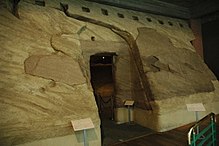
The temple of Ellesija, today in the Museo Egizio in Turin
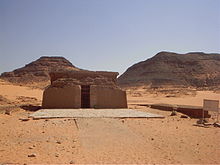
Temple in Amada

Needle of Cleopatra in New York
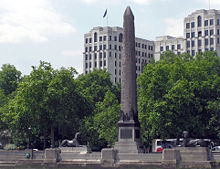
Needle of Cleopatra in London, seen from the Thames
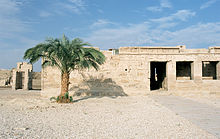
Sanctuary of the Ur-Amun in Medinet Habu
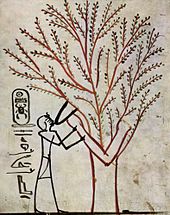
Thutmosis III is suckled by the holy tree (Isched tree)

Access to the grave
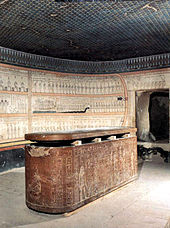
Burial chamber
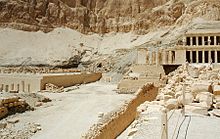
Remains of the mortuary temple at Deir el-Bahari between the mortuary temple of Mentuhotep II. (left) and the mortuary temple of Hatshepsut (right)
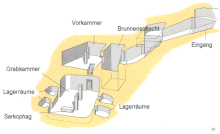
General view KV34
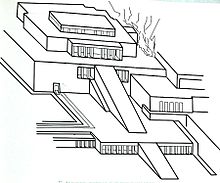
Reconstruction of the temple of the dead in Deir el-Bahari according to Jadwiga Lipińska
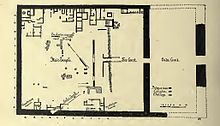
Plan of the incompletely excavated mortuary temple at el-Qurna from 1905
.jpg)
Ptah temple in Karnak

Representation on the 7th pylon: Thutmosis III slaying the enemies
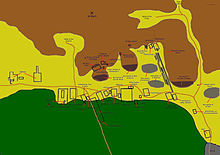
Map with the temples of the dead in Thebes-West

The sacred lake

Obelisk on the Lateran Square in Rome from the East Temple in Karnak
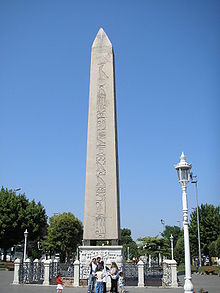
Thutmosis III obelisk on the Hippodrome (Constantinople) (Sultan Ahmed Square) in Istanbul.

Plant representations in the "botanical garden
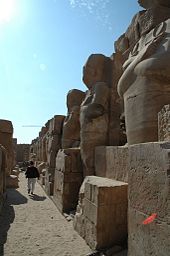
Osiris pillar in the Wadjit
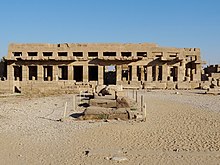
Ach-menu in the temple of Amun-Re

Barque sanctuary in the Karnak temple
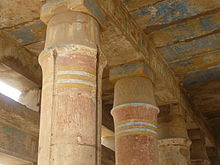
Tent pole columns in the Ach-menu
Questions and Answers
Q: Who was Thutmose III?
A: Thutmose III was the sixth pharaoh of the Eighteenth Dynasty in Egypt.
Q: How long was Thutmose III pharaoh for?
A: Thutmose III was pharaoh for almost 54 years, from the age of two until his death at age fifty-six.
Q: Who was Hatshepsut?
A: Hatshepsut was Thutmose III's stepmother and aunt, who was also a pharaoh, and probably the actual ruler for the first part of his reign.
Q: Who succeeded Thutmose III as pharaoh?
A: Thutmose III appointed his son and successor, Amenhotep II, as his junior co-regent during the final two years of his reign.
Q: Did Thutmose III have any other sons?
A: Yes, Thutmose III had a firstborn son and heir to the throne named Amenemhat, but he died before Thutmose III.
Q: What did Thutmose III do during his reign?
A: Thutmose III created the largest empire Egypt ever had, conquering lands from the Niya Kingdom in northern Syria to the Fourth Cataract of the Nile in Nubia through 17 campaigns.
Q: Where was Thutmose III buried?
A: Thutmose III was buried in the Valley of the Kings in Egypt among other kings from his period.
Search within the encyclopedia